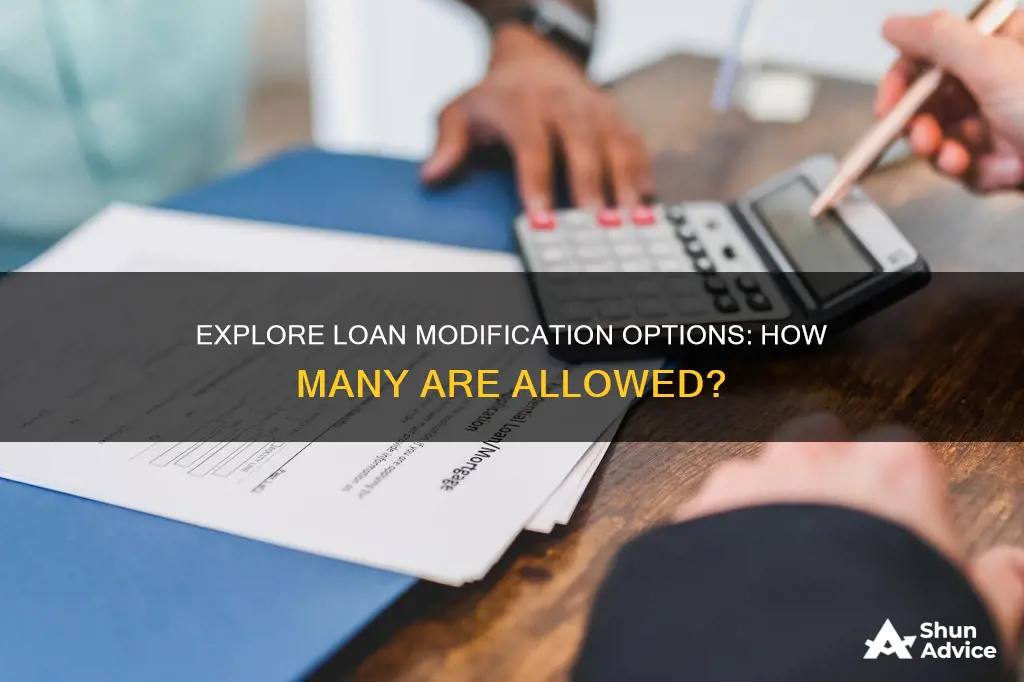
If you are struggling to make your mortgage payments, a loan modification can be a good option to modify your mortgage. The number of loan modifications you are allowed depends on your specific lender and their guidelines. There is no legal limit on how many modification requests you can make, but lenders are generally more willing to grant a modification if it is your first request. Most government mortgages and public lenders allow up to three loan modifications, but private lenders are not required to review your modification application and may restrict the number of modifications. An attorney can help you with the loan modification process and advise on other options that may be available to you.
| Characteristics | Values |
|---|---|
| Number of loan modifications allowed | There is no legal limit on how many loan modifications can be requested. However, the number of modifications allowed depends on the lender and their guidelines. |
| Loan modifications for FHA loans | FHA loans allow two to three loan modifications throughout the life of the loan. |
| Loan modifications for Fannie Mae or Freddie Mac | Fannie Mae and Freddie Mac mortgages are limited to three to five loan modifications. |
| Loan modifications for private investors | Private investors are not required to review modification applications and are less likely to approve modifications. |
| Loan modification application process | The application process typically remains the same for each subsequent loan modification application. |
| Loan modification approval factors | Lenders review income, expenses, bank statements, taxes, and hardship letters to determine approval. |
| Loan modification benefits | Loan modifications can help lower interest rates, reduce principal amounts, or defer payments. |
| Loan modification alternatives | Alternatives to loan modifications include Chapter 13 bankruptcy, which allows for repayment of arrears and taxes over a period of time. |
What You'll Learn

Loan modification eligibility depends on the lender
Loan modification is a change made to the terms of an existing loan by a lender. It may involve a reduction in the interest rate, an extension of the length of time for repayment, a different type of loan, or any combination of these. The number of loan modifications you are allowed depends on your specific lender and what they allow.
Different mortgage lenders have different loan modification guidelines. To determine if you might be eligible for a second loan modification, you must first find out who your lender is and what their policies are. Government mortgages and public lenders generally allow up to three loan modifications. However, a private lender can restrict the number of loan modifications you can get approved for, so you’re not entitled to multiple modifications. With a VA loan, for instance, you can’t get more than three loan modifications throughout the life of your loan. FHA loans, on the other hand, allow two to three loan modifications throughout the life of the loan.
To be eligible for a loan modification, you must state why you cannot make your current mortgage payment due to some financial hardship. You will need to provide all the required documentation to the lender for evaluation, including a formal application, pay stubs, financial statements, proof of income, bank statements, and tax returns, as well as a hardship statement. A loan modification attorney can help you with the loan modification application process and determine your eligibility.
Motive Loan: Safe or Risky Option?
You may want to see also

FHA loans allow two to three modifications
The Federal Housing Administration (FHA) offers a range of options for borrowers facing financial hardship and struggling to make their mortgage payments. While the number of loan modifications allowed was not explicitly stated, FHA-insured mortgages can be modified to help borrowers retain their homes.
In April 2022, the Department of Housing and Urban Development (HUD) introduced a 40-year loan modification option to help FHA borrowers impacted by the COVID-19 pandemic. This option reduces the borrower's monthly payment by extending the repayment period. The rule change aligns FHA with modifications offered by the Federal National Mortgage Association (Fannie Mae) and the Federal Home Loan Mortgage Corporation (Freddie Mac), which both provide 40-year loan modifications.
FHA borrowers can also take advantage of the COVID-19 Advance Loan Modification (ALM), which permanently reduces the monthly principal and interest payment by a minimum of 25%. Additionally, the Payment Supplement option, established in February 2024, allows eligible borrowers to temporarily reduce their monthly mortgage payment for three years without modifying the loan term.
FHA also offers a range of other COVID-19 Loss Mitigation Options, including the Home Retention Options and Home Disposition Options, such as the Pre-Foreclosure Sale and Deed-in-Lieu of Foreclosure. These options aim to assist borrowers in financial distress by providing alternatives to foreclosure and helping them stay in their homes.
It is important to note that the availability of these options may vary over time, and borrowers should contact their mortgage servicer or the FHA Resource Center to discuss their specific circumstances and explore the most suitable options for their situation.
Title Loans in Indiana: What's the Legal Status?
You may want to see also

Foreclosure defence and loan modifications
Foreclosure is a scary prospect, and it can be difficult to know your rights and options when facing it. A foreclosure defence attorney can help you navigate this stressful time and ensure your rights are protected. They can also help you review your legal options and get your finances on track.
Loan modifications can be a good way to modify your mortgage and prevent foreclosure if you are struggling to make payments. A loan modification lawyer can help you determine your options and eligibility for a second loan modification, as well as guide you through the application process. The number of loan modifications you are allowed depends on your lender and investor's guidelines. Most government mortgages and public lenders allow up to three modifications, but private lenders may restrict this number. FHA loans, for example, allow two to three modifications and are eligible for modification every two years.
It is important to be cautious of scams when considering loan modifications. Official-sounding names, phone calls, direct mailing, or door-to-door solicitations may be used to deceive homeowners. You should only discuss loan modifications with your mortgage lender or a trusted attorney.
If you have already had several loan modifications and are facing foreclosure again, Chapter 13 bankruptcy might be an option to consider. This allows you to pay back the amount you are behind over 60 months, in addition to your regular monthly mortgage payments. You can file for Chapter 13 bankruptcy even if you are in foreclosure or if the foreclosure has gone to judgment.
Amortization Strategies: Repay Your Loan Efficiently
You may want to see also

Bankruptcy and loan modifications
The number of loan modifications allowed depends on the lender and their guidelines. Government mortgages and public lenders typically allow up to three modifications, whereas private lenders may restrict the number of approved modifications.
If you have reached the maximum number of loan modifications allowed by your lender, you may need to consider other options, such as bankruptcy. Bankruptcy can assist homeowners in resolving their debt issues and pursuing a mortgage loan modification. Chapter 13 bankruptcy, for example, allows you to pay arrears to the mortgage company over 60 months, in addition to your regular monthly mortgage payments. This option is available even if you are in foreclosure.
Chapter 13 bankruptcy also allows you to address other debts, such as income tax and car loans. It provides a framework for homeowners to reorganize their finances and modify secure debts on their property. This can make their financial situation more appealing to lenders.
It is important to note that bankruptcy does not change the terms of your loan. However, it can provide temporary relief from foreclosure and give homeowners time to explore their options. Consulting with an experienced bankruptcy attorney can help determine the best course of action for your specific situation.
The Luxury of Lavish Green: Nature's Opulent Splendor
You may want to see also

Loan modification application process
The loan modification application process typically involves the following steps:
Step 1: Understand the Requirements and Your Eligibility
Before applying, it's essential to understand the requirements and assess your eligibility. Lenders typically require you to demonstrate financial hardship and that your loan payments are causing difficulty. The home for which you seek the modification should be your primary residence, not an investment or rental property. Additionally, most lenders will require you to be at least one regular mortgage payment behind or show that a missed payment is imminent.
Step 2: Gather the Necessary Documentation
You will need to provide comprehensive financial information, including current income documentation (pay stubs, federal tax returns), bank statements, investment portfolios, and details of any other real estate or assets you own. You will also need to provide information about your mortgage and specific details of your hardship situation.
Step 3: Submit the Application
You will need to submit a complete application to your loan servicer or lender. This typically involves sending in all the requested financial information and supporting documents. Be sure to include your name, loan number, and contact information on each page of every document to avoid any misplaced pages. You can usually submit your application by mail, overnight mail, through an online portal, or secure email.
Step 4: Wait for Processing and Review
The processing time for loan modification applications can vary, typically taking 90 days or longer. During this time, your lender may perform credit checks and assess your financial situation. In some cases, they may ask you to make a series of trial payments, which are often lower than your current payment amount. These trial payments may or may not reflect the final modified payment amount.
Step 5: Receive the Decision and Review New Terms
Once your application is processed, you will be notified of the decision. If approved, you will receive an updated loan agreement with modified terms, including a new payment schedule. Review these new terms carefully, as they may include changes to the interest rate, repayment period, or other loan conditions.
It is important to note that the specific process and requirements may vary depending on your lender and the type of loan you have. Additionally, the number of loan modifications you are allowed depends on your specific lender's guidelines. If you have questions or need assistance, consider consulting a loan modification attorney or a HUD-approved housing counselor.
Sunshine Loans: Safe or Risky Business?
You may want to see also
Frequently asked questions
The number of loan modifications allowed varies depending on the lender and investor. There is no legal limit on the number of loan modification requests that can be made, but lenders are generally more willing to grant a modification if it is the first time. Most government mortgages and public lenders allow up to three modifications. FHA loans allow two to three modifications and Fannie Mae and Freddie Mac mortgages are limited to three to five modifications.
A loan modification allows you to work with your mortgage lender to adjust your mortgage payments and make your financial situation more manageable.
A loan modification lawyer can help you with the application process. You will need to collect the necessary documents, including bank statements, income, expenses, and taxes.
If you have received the maximum number of loan modifications, you may want to consult with an attorney to explore other options, such as a different type of loan or bankruptcy.
Loan modifications can increase the length of your mortgage, typically by 30-40 years, and may result in a lower interest rate or reduced principal.







